Persistent and cheery, curious and assertive, the Tufted Titmouse forms part of a cadre of birds gracing the snow, sleet, and rain of Wisconsin winters. The birds are generally non-migratory, opportunistically occupying woodpecker cavities during the summer breeding season and lining these nests with fur. Winter birds are almost always male-female pairs, though sometimes juveniles join on the winter territory, where the birds have benefitted from human feeding, and have thus expanded their range across many decades. Good evidence of this breeding expansion shows up in Wisconsin’s Breeding Bird Atlas (below).
WBBA1 range of the Tufted Titmouse.
WBBA2 range of the Tufted Titmouse.
This notable range expansion has seen one edge of the Tufted Titmouse population expand into more northern US areas like Wisconsin, Minnesota, and northeastern states, often along river valleys. At the same time, its northern expansion has seen declines of birds in the southern United States. The map below shows abundance declines of 30-50% through much of the south.
Abundance trends in Tufted Titmice populations.
Reasons for this decline might include climate change, altered habitat, or declining availability or competition for cavities.
On their winter territories, Tufted Titmice hold down about 13 acres, and occasionally encounter disputes on the edges of territories. Like related chickadees, titmice will cache food items throughout the winter, often visiting feeders, hulling seeds, and depositing those seeds nearby.
You can find Tufted Titmice at Faville Grove in forested areas. Breeding pairs have found Faville Woods suitable, with ample large trees and cavities. Look for medium sized birds with a black and gray crest, rusty flanks, and gray overall. Listen for its characteristic and dogged call: “Peter, Peter, Peter!”
Written by Drew Harry, Faville Grove Sanctuary land steward
Cover image: A Tufted Titmouse perched on a twig (photo via Pixabay).







